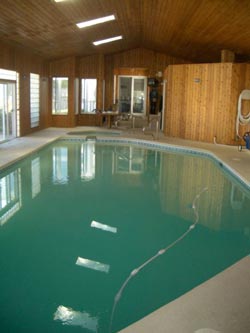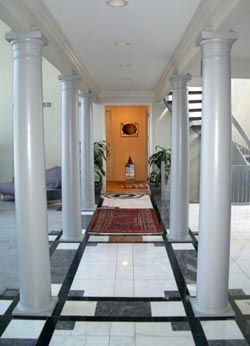Get a walk-though of this home showing everything from rain barrels to geothermal-energy to "energy art".
List price: $2.8 million
The Property: With an indoor pool, a typically hard-to-heat two-story living room and foyer, and a total of 9,000 square feet of indoor space, this Highland Park house used to be an energy hog. But thanks to the installation of solar and geothermal energy collectors, it now consumes a very small share—if any—of the utility energy it used to demand.
|
|
|
|
“I wanted to prove to myself that I could live sustainably,” says Brad Snower, who has owned the house since August 2006. “We all have to try, or there’s trouble for everyone in the future.”
The house was built on a one-acre lot 15 years ago with no thought toward energy conservation. Its huge west-facing windows let the sun’s warmth heat some of the interior, but that’s passive use of solar power. The house now actively—overactively, you might say—collects solar energy (via its broad south-facing roof) and harnesses geothermal energy with an underground air-cooling system (via a cluster of pipes buried beneath a portion of the front yard).
Snower, an entrepreneur with roles in several businesses that develop or market alternative energy sources, first installed the geothermal-energy system and one part of the current solar installation, a string of solar thermal panels that capture solar energy to heat water for the pool and other uses. He then calculated that together they had cut the house’s electricity intake from 7,000 kilowatts to 2,400 kilowatts. (Before the systems are installed, it’s only possible to estimate what the savings will be.) With 2,400 kilowatts to go to get to zero, Snower then installed a second set of solar panels—photovoltaics that convert solar energy to 3,000 kilowatts of power.
He has also “painted” most of the house’s exterior with a nano-ceramic coating that is designed to seal it supertight; for an existing home, this is an alternative to the tight building and insulating methods used in new construction.
You can’t quite call this an off-the-grid house, because it still uses natural gas for cooking. A buyer might take the next step and convert to an electric stove, thus opting out of the power grid entirely.
Price Points: Snower swapped some commercial property for this house, so I don’t know what he paid for it. (He wouldn’t say.) His total investment in the green rehab would have come to $200,000, he says, but this was defrayed by about $40,000 in government grants that encourage energy conservation and the use of alternative energy sources.
Listing Agent: Snower is selling the house without an agent. “I had it listed with an agent for a month, but they were unable to explain how this house works,” he says. Brad Snower: 808-631-8587; mr.snower@yahoo.com.





